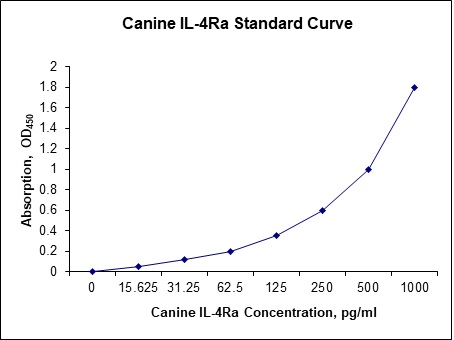Nori Canine IL-4Ra ELISA Kit
$461.00 – $832.00
DataSheet CoA SDS
This ELISA kit is for quantification of IL-4Ra in dog. This is a quick ELISA assay that reduces time to 50% compared to the conventional method, and the entire assay only takes 3 hours. This assay employs the quantitative sandwich enzyme immunoassay technique and uses biotin-streptavidin chemistry to improve the performance of the assays. An antibody specific for IL-4Ra has been pre-coated onto a microplate. Standards and samples are pipetted into the wells and any IL-4Ra present is bound by the immobilized antibody. After washing away any unbound substances, a detection antibody specific for IL-4Ra is added to the wells. Following wash to remove any unbound antibody reagent, a detection reagent is added. After intensive wash a substrate solution is added to the wells and color develops in proportion to the amount of IL-4Ra bound in the initial step. The color development is stopped, and the intensity of the color is measured.
Alternative names for IL-4Ra: interleukin 4 receptor alpha
This product is for laboratory research use only not for diagnostic and therapeutic purposes or any other purposes.
- Description
- How Elisa Works
- Product Citations
- Reviews (0)
Description
Nori Canine IL-4Ra ELISA Kit Summary
Alternative names for IL-4Ra: interluekin 4 receptor alpha,
Alternative names for canine: dog
| Assay Type | Solid Phase Sandwich ELISA |
| Format | 96-well Microplate or 96-Well Strip Microplate |
| Method of Detection | Colorimetric |
| Number of Targets Detected | 1 |
| Target Antigen Accession Number | A0A8C0PTC2 |
| Assay Length | 3 hours |
| Quantitative/Semiquantitative | Quantitative |
| Sample Type | Plasma, Serum, Cell Culture, Urine, Cell/Tissue Lysates, Synovial Fluid, BAL, |
| Recommended Sample Dilution (Plasma/Serum) | No dilution for sample <ULOQ; sufficient dilution for samples >ULOQ |
| Sensitivity | 3 pg/mL |
| Detection Range | 15.63-1000 pg/mL |
| Specificity | Natural and recombinant canine IL-4Ra |
| Cross-Reactivity | < 0.5% cross-reactivity observed with available related molecules, < 50% cross-species reactivity observed with species tested. |
| Interference | No significant interference observed with available related molecules |
| Storage/Stability | 4 ºC for up to 6 months |
| Usage | For Laboratory Research Use Only. Not for diagnostic or therapeutic use. |
| Additional Notes | The kit allows for use in multiple experiments. |
Standard Curve
Kit Components
1. Pre-coated 96-well Microplate
2. Biotinylated Detection Antibody
3. Streptavidin-HRP Conjugate
4. Lyophilized Standards
5. TMB One-Step Substrate
6. Stop Solution
7. 20 x PBS
8. Assay Buffer
Other Materials Required but not Provided:
1. Microplate Reader capable of measuring absorption at 450 nm
2. Log-log graph paper or computer and software for ELISA data analysis
3. Precision pipettes (1-1000 µl)
4. Multi-channel pipettes (300 µl)
5. Distilled or deionized water
Protocol Outline
1. Prepare all reagents, samples and standards as instructed in the datasheet.
2. Add 100 µl of Standard or samples to each well and incubate 1 h at RT.
3. Add 100 µl of Working Detection Antibody to each well and incubate 1 h at RT.
4. Add 100 µl of Working Streptavidin-HRP to each well and incubate 20 min at RT.
5. Add 100 µl of Substrate to each well and incubate 5-30 min at RT.
6. Add 50 µl of Stop Solution to each well and read at 450 nm immediately.
Background:
IL-4Ra is the alpha chain of the interleukin-4 receptor encoded by IL4Ra gene,[1] a type I transmembrane protein that can bind interleukin 4 and interleukin 13 to regulate IgE antibody production in B cells. Among T cells, IL-4Ra also can bind interleukin 4 to promote differentiation of Th2 cells. Besides a membrane-bound form, a soluble form of IL-4Ra can be produced by an alternate splice variant or by proteolysis of the membrane-bound protein, and this soluble form can inhibit IL4-mediated cell proliferation and IL5 upregulation by T-cells. Interactions of IL-4 with TNFα promote structural changes to vascular endothelial cells, thus playing an important role in tissue inflammation.[2] The binding of IL-4 or IL-13 to the IL-4 receptor on the surface of macrophages results in the alternative activation of those macrophages. Alternatively activated macrophages (AAMΦ) downregulate inflammatory mediators such as IFNγ during immune responses, particularly with regards to helminth infections.[3] IL4 signaling also determines the levels of CD20 on normal and malignant B cells by activating the transcription factor STAT6.[4] CircIL4R activates the PI3K/AKT signaling pathway via the miR-761/TRIM29/PHLPP1 axis and promotes proliferation and metastasis in colorectal cancer.[5] Rab1A promotes IL-4R/JAK1/STAT6-dependent metastasis and determines JAK1 inhibitor sensitivity in non-small cell lung cancer.[6] M1 macrophage exosomes engineered to foster M1 polarization and target the IL-4 receptor inhibit tumor growth by reprogramming tumor-associated macrophages into M1-like macrophages.[7]
References
- Galizzi JP, et al. (1990) Int Immunol 2 (7), 669-675.
- Tundup S, et al. (2012). Ann. N. Y. Acad. Sci. 1253 (1): E1–E13.
- Sandova V, et al. (2021). Haematologica. doi:3324/haematol.2021.278644.
- Ikizawa K, Yanagihara Y (2000). Biochem. Biophys. Res. Commun. 268 (1): 54–9.
5. Jiang T, et al. (2021)Mol Cancer 20 (1), 167.6. Huang T, et al. (2021) Cancer Lett 523, 182-194.7. Gunassekaran GR, et al. (2021) Biomaterials 278, 121137.
Product Citations
Be the first to review “Nori Canine IL-4Ra ELISA Kit”
You must be logged in to post a review.




























Reviews
There are no reviews yet.